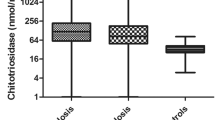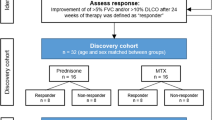Abstract
Background
Sarcoidosis is a multisystem granulomatous disease of unknown etiology. No suitable biomarkers are available to evaluate the evolution of this disease, which still has an unpredictable clinical course. Some years ago our research group proposed chitotriosidase as a potential biomarker with prognostic value, that however needed to be validated.
Aims and methods
The aims of this study were to evaluate the sensitivity and specificity of chitotriosidase in a population of 232 sarcoidosis patients under the observation of our Sarcoidosis Regional Referral Centre in Siena and to analyse enzyme concentrations in different disease phenotypes (as defined by the recently published COS classification) to define its prognostic value.
Results
Serum chitotriosidase concentrations were significantly higher in patients than in healthy controls (p < 0.0001) and were directly correlated with ACE levels (r = 0.25, p < 0.0001). ROC curve analysis revealed 88.6 % sensitivity and 92.8 % specificity. Enzyme concentrations were significantly higher in stage 3 sarcoidosis than in stage 0 (p = 0.02). The lowest concentrations of chitotriosidase were found in untreated patients in remission (COS-1), while the highest enzyme concentrations were found in symptomatic patients with persistent disease on steroids and with functional deterioration in the last year (COS-9). In COS-9 subgroup, chitotriosidase decreased significantly after the increasing of steroid dose or the introduction of a new immunosuppressant therapy (p < 0.01).
Conclusion
Chitotriosidase proved to be a biomarker with good sensitivity and specificity that is easily detected in serum. It can be proposed in clinical practice to identify progressive patients requiring close follow-up, to detect relapses and to evaluate the effects of therapy.




Similar content being viewed by others
Abbreviations
- BAL:
-
bronchoalveolar lavage
- ACE:
-
angiotensin converting enzyme
References
Hunninghake GW, Costabel U, Ando M, et al. ATS/ERS/WASOG statement on sarcoidosis. Sarcoidosis Vasc Diffuse Lung Dis. 1999;16:149–73.
Yamamoto M, Sharma OP, Hosoda Y. Special report: the 1991 descriptive definition of sarcoidosis. Sardoidosis. 1992;9:33–4.
Agostini C, Trentin L, Facco M, et al. Role of IL-15, IL-2, and their receptors in the development of T cell alveolitis in pulmonary sarcoidosis. J Immunol. 1996;157:910–8.
Agostini C, Semenzato G. Cytokines in sarcoidosis. Semin Respir Infect. 1998;13:184–96.
Prior C, Knight RA, Herold M. Pulmonary sarcoidosis: patterns of cytokine release in vitro. Eur Respir J. 1996;9:47–53.
Gurrieri C, Bortoli M, Brunetta E, et al. Cytokines, chemokines and other biomolecular markers in sarcoidosis. Sarcoidosis Vasc Diffuse Lung Dis. 2005;22 Suppl 1:S9–S14.
Baudin B. ACE for sarcoidosis diagnosis. Pathol Biol. 2005;53:183–8.
Lynch JP, Kazerooni EA, Gay SE. Pulmonary sarcoidosis. Clin Chest Med. 1997;18:755–85.
Judson MA, Baughman RP, Thompson BW, et al. Two years prognosis of sarcoidosis: the ACCESS experience. Sarcoidosis Vasc Diffuse Lung Dis. 2003;20:204–11.
Corte TJ, Wells AU, Nicholson AG, et al. Pulmonary hypertension in sarcoidosis: a review. Respirology. 2011;16:69–77.
Ziegenhagen MW, Rothe ME, Schlaak M, et al. BAL and sierological parameters reflecting the severity of sarcoidosis. Eur Respir J. 2003;21:407–13.
Hunninghake GW, Gilbert S, Pueringer R, et al. Outcome of the treatment of sarcoidosis. Am J Respir Crit Care Med. 1994;149:893–8.
Wasfi YS, Rose CS. A new tool to assess sarcoidosis severity. Chest. 2006;129:1234–45.
Prasse A, Katic C, et al. Phenotyping sarcoidosis from a pulmonary perspective. Am J Respir Crit Care Med. 2008;177:330–6.
Baughman RP, Nagai S, et al. Defining the clinical outcome status (COS) in sarcoidosis: results of WASOG Task Force. Sarcoidosis Vasc Diffuse Lung Dis. 2011;28:56–64.
Bargagli E, Mazzi A, Rottoli P. Markers of inflammation in sarcoidosis: blood, urine, BAL, sputum and exhaled gas. Clin Chest Med. 2008;29:445–58.
Scadding JG. Prognosis of intrathoracic sarcoidosis in England: a review of 136 cases after five years' observation. BMJ. 1961;2:1165–72.
Boot RG, Renkema GH, Verhoek M, et al. The human chitotriosidase gene. Nature of inherited enzyme deficiency. J Biol Chem. 1998;273:25680–5.
Michelakakis H, Dimitriou E, Labadaridis I. The expanding spectrum of disorders with elevated plasma chitotriosidase activity: an update. J Inherit Metab Dis. 2004;27:705–6.
Altarescu G, Rudensky B, Abrahamov A, et al. Plasma chitotriosidase activity in patients with beta-thalassemia. Am J Hematol. 2003;72:285–6.
Barone R, Simpore J, Malaguarnera L, et al. Plasma chitotriosidase activity in acute Plasmodium falciparum malaria. Clin Chim Acta. 2003;331:79–85.
Rottoli P, Magi B, Perari MG, et al. Cytokine profile and proteome analysis in BAL of patients with sarcoidosis, pulmonary fibrosis associated with systemic sclerosis and idiopathic pulmonary fibrosis. Proteomics. 2005;5:1423–30.
Aguilera B, Ghauharali-Van der Vlugt K, Helmond MT, et al. Transglycosidase activity of chitotriosidase: improved enzymatic assay for the human macrophage chitinase. J Biol Chem. 2003;278:40911–6.
Grosso S, Margollicci MA, Bargagli E, et al. Serum levels of chitotriosidase as a marker of disease activity and clinical stage in sarcoidosis. Scand J Clin Lab Invest. 2004;64:57–62.
Bargagli E, Margollicci MA, Perrone A, et al. Chitotriosidase analysis in bronchoalveolar lavage of patients with sarcoidosis. Sarcoidosis Vasc Diffuse Lung Dis. 2007;24:59–64.
Rothkranz-Kos S, van Dieijen-Visser MP, Mulder PG, et al. Potential usefulness of infiammatory markers to monitor respiratory functional impairment in sarcoidosis. Clin Chem. 2003;49:1510–7.
Bargagli E, Margollicci M, Luddi A, et al. Chitotriosidase activity in patients with interstitial lung diseases. Resp Med. 2007;101:2176–81.
Bargagli E, Margollicci M, Nikiforakis N, et al. Chitotriosidase activity in the serum of patients with sarcoidosis and pulmonary tuberculosis. Respiration. 2007;74(5):548–52.
Tercelj W, Salobir B, Siwcic S, et al. Chitotriosidase activity in sarcoidosis and some other pulmonary diseases. Scand J Clin Lab Invest. 2009;69:575–8.
Brunner J, Scholl-Bürgi S, Zimmerhackl LB. Chitotriosidase as a marker of disease activity in sarcoidosis. Rheumatol Int. 2007;27:1171–2.
Newman LS, Rose CS, Bresnitz EA, and the ACCESS Research Group. A case-control etiological study of sarcoidosis-environmental and occupational risk factors. Am J Crit Care Med. 2004;170:1324–30.
Tercelj M, Stopincek S, Salobir B, et al. In vitro and in vivo reactivity to fungal cell wall agents in sarcoidosis. Clin Exp Immunol. 2011;166:87–93.
Tercelj M, Salobir B, Zupancic M, Rylander R. Antifungal medication is efficient in the treatment of sarcoidosis. Ther Adv Respir Dis. 2011;5(3):157–62.
Tercelj M, Rott T, Rylander R. Antifungal treatment in sarcoidosis- a pilot intervention trial. Resp Med. 2007;101:774–8.
Miyoshi S, Hamada H, Kadowaki T, et al. Comparative evaluation of serum markers in pulmonary sarcoidosis. Chest. 2010;137:1391–7.
Tzouvelekis A, Kouliatsis G, Anevlavis S, et al. Serum biomarkers in interstitial lung diseases. Respir Res. 2005;6:78.
Hunninghake GW, Bedell GN, Zavala DC, et al. Role of interleukin-2 release by lung T-cells in active pulmonary sarcoidosis. Am Rev Respir Dis. 1983;128:634–8.
Prior C, Barbee RA, Evans PM, et al. Lavage versus serum measurements of lysozyme, angiotensin converting enzyme and other inflammatory markers in pulmonary sarcoidosis. Eur Respir J. 1990;3:1146–54.
Author information
Authors and Affiliations
Corresponding author
Additional information
All the authors have no conflict of interest to declare
The present work was performed at Department of Clinical Medicine and Immunology Respiratory Disease Section, no funding sponsors to declare.
Rights and permissions
About this article
Cite this article
Bargagli, E., Bennett, D., Maggiorelli, C. et al. Human Chitotriosidase: a Sensitive Biomarker of Sarcoidosis. J Clin Immunol 33, 264–270 (2013). https://doi.org/10.1007/s10875-012-9754-4
Received:
Accepted:
Published:
Issue Date:
DOI: https://doi.org/10.1007/s10875-012-9754-4




